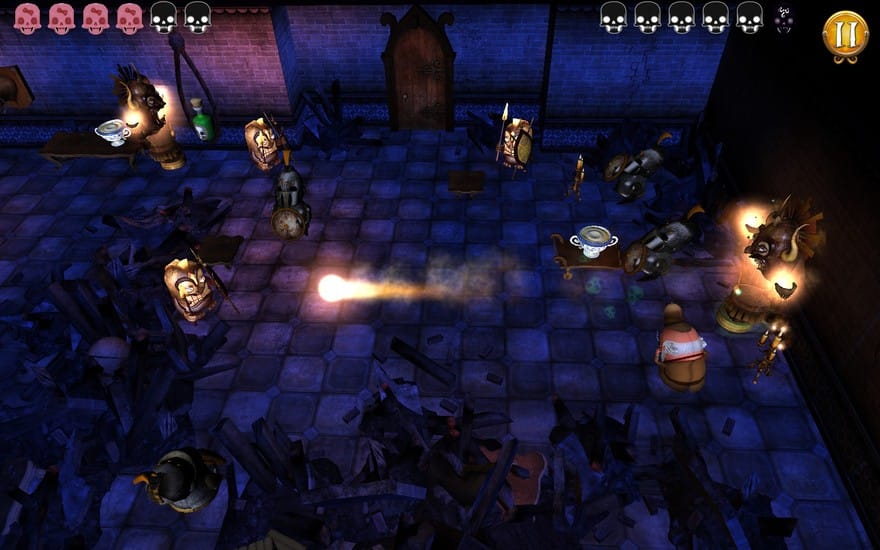How does Wayward Manor fit into Neil Gaiman’s oeuvre? It doesn’t.

Of the people who were hotly anticipating the release of The Odd Gentlemen’s Wayward Manor, it is probably safe to assume that the vast majority were Neil Gaiman fans. A relatively small developer, The Odd Gentlemen’s audience is meager compared to that of Gaiman, who has been a beloved and famed author since he created The Sandman comicbook back in 1989. But he had been crafting his voice long before that. He grew up with a book in his hand, devouring the contents of his local library’s shelves, and upon becoming an adult gained a worldliness as a journalist before publishing work as a fiction writer. The blend of real-world experience and an immense literary knowledge is, perhaps, what gives Gaiman such mastery over narrative mediums.
His fantasies feel real, while his realities flirt with magic—a thin line always separates the two. The joy of Gaiman’s work is watching his protagonists cross over it and back again, such as in Neverwhere, when the extremely average Richard Mayhew helps the otherworldly girl Door and, in doing so, find himself rejected by the London he knows and stuck in the magical world of “London Below.” In Stardust, Tristran Thorn, a small town boy in love with a small town girl, crosses the wall that separates humankind from Fae-kind in order to chase a falling star and win his love’s hand in marriage. Gaiman is a master of weaving stories in which we get to leave reality and experience something magical.
Unfortunately, with the release of the game, it’s clear that promise will remain unfulfilled.
The promise of Wayward Manor, then, was a chance to interact with these stories in a way never possible with his printed texts; the game offered the chance to go inside one of Gaiman’s worlds as the protagonist. Unfortunately, with the release of the game, it’s clear that promise will remain unfulfilled. Wayward Manor goes most wayward in terms of game design, such that the possibility of interacting inside a Gaiman story in a meaningful way becomes impossible. We are left with a game that, rather than immersing us in story, stands as proof that games don’t just need better writer to make game stories better. The Odd Gentlemen had one of this generation’s greatest storytellers on board, and still failed to marry a rich Gaiman narrative into its game design.
The problem, however, isn’t the inability of Gaiman’s work to cross media. His work has done so with great success before: the stop-motion adaptation of his book Coraline worked beautifully; director Henry Selick struck the perfect chord between children’s story and horror tale. Gaiman spent a good deal of time collaborating with Selick, and it was apparent the two shared a vision of the story. Gaiman once said that while it was easy for him to write about trees devolving into the mere idea of trees, Selick’s ability to visually replicate the idea was evidence of his true craftsmanship. Additionally, Gaiman has fared well in audio-only mediums; his audiobooks, for which he is almost always the voice, have a cadence and pitch that matches the narrative beats of the story. For the American Gods audiobook, Gaiman knew his British accent would be out of place, and so he asked George Guidall to narrate it. His children’s book, Wolves in the Walls, was successfully adopted for the stage by the National Theatre of Scotland utilizing Henson-esque puppetry.
Yet Wayward Manor lacks any true Gaiman aesthetic. When the game was pitched, Gaiman said that he’d long wanted to create a video game, but was waiting for a story that necessitated such a medium. He said the story he’d conceive of for Wayward Manor didn’t feel like a novel, “it felt like something you’d have to experience yourself.” Unfortunately, every bit of Gaiman’s aesthetic that is present in the game is not playable, and what is playable lacks any of Gaiman’s flair.

The story frame for the game is undeniably Gaiman’s. The story is told from the perspective of a Victorian house which desperately wants to cleanse itself of its contemporary human “infestation,” and so seeks out the aid of a ghost. Gaiman himself acts as the voice of the house, while players take on the role of the ghost, who must help scare the humans from the house. Beginning in the attic, Gaiman’s voice instructs the player to scare a maid and a burglar after a valuable locked chest. As the player moves from room to room, the house reminisces about its stately glory days before it became full of trinkets, dust, tacky décor and, worst of all, humans. The human characters also have some familiar Gaiman flair; a duo named Patience and Fortitude, for example, are impulsive twins with a fierce and insatiable appetite for candy. Gaiman has always relished such allegories: the character Door in Neverwhere possessed the power to open pathways between two locations; Shadow Moon in American Gods was the Norse god of light.
Beyond these small touches, though, is a threadbare game. You’re constantly running into the walls of the manor: the player is confined to one room at a time, solving overly simplified point-and-click puzzles. The player is as trapped as the ghost in the house, unable to free herself from the mechanical shackles. The mechanical clunkiness of the game and its limited interactivity are only half the problem, however. Gaiman’s voice and ideas pop in during cutscene audio, but never while we’re playing. The game plays as two poorly pasted-together objects: an audiobook short story and a casual point-and-click game, both pieces created by separate entities rather than by collaborating artists.
It seems, perhaps, that Gaiman’s desire to make a videogame was not coupled with a passion for the medium itself.
Perhaps the failure of the game to embody Gaiman’s aesthetic boils down to Gaiman’s passion, or at the very least, a deep understanding of and respect for the mediums to which his works were previously adapted. Over the years Gaiman has been vocal about his love of comics, film, theatre, music, and radio: all mediums to which his work has been successfully adopted. On the other hand, Gaiman has made little mention of videogames in the past, even admitted that he primarily used his Wii for fitness rather than gaming. It seems, perhaps, that Gaiman’s desire to make a videogame was not coupled with a passion for the medium itself.
In fairness to both Gaiman and The Odd Gentlemen, it’s also worth noting that Gaiman’s successes in other mediums have largely been from adaptations of works he’d already created. Gaiman’s creative process has never been a particularly collaborative or speedy one: He frequently gets the idea for a story long before he write it. For instance, he first thought of the story for The Graveyard Book while watching his young son ride his bicycle through a graveyard, but his son was out of college by the time it was written. Gaiman is also known for hiding away when he writes and travelling to places where his only focus is his writing. Gaiman’s particular aesthetic, it could be said, requires time and solitude to ferment into its unique flavor. Wayward Manor could’ve used some more time on the shelf.



